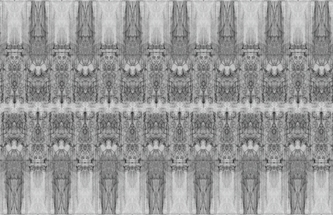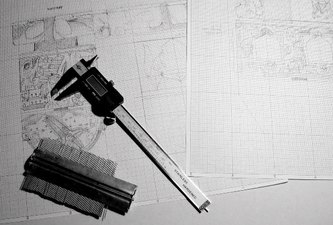17March – 3 April 2010
DRAWINGSPACES, FÁBRICA BRAÇO DE PRATA
Timeline_Drawing Time
Guida Casella
Timeline _ Drawing Time
Guida Casella will be showing Archaeological Illustration Drawings, that she has been making for the past 12 years: Excavation Plans and Sections, Small Finds Illustration and Historical Reconstructions.
This specific kind of drawing (illustration) with its genesis in Enlightenment collector’s catalogues, in Geologist’s survey drawing, and History Painting is an exhaustive and descriptive Drawing. It aims to objectivity, but it can never be one hundred percent so. It is hand made, and above all, it is not made by a machine, but by an artist. Even if the aim is to produce a cold objective Drawing, there is always something that aspires to emotion.
Being a ‘register’ drawing with the aim of producing a document which communicates, it can also be perceived through its aesthetical value. The graphic signs that allow this drawing to pursue its objective to communicate are the same material that in another context can transmit a different meaning.
And it is in this balance between:
Guida Casella, working in Archaeology, professionally producing scientific illustrations, handles very old objects. They can be 3000 yrs old pottery, or 800 yrs old tombs. These objects hold in themselves the passage of time.
How does this contact that witnesses the past, inform the work of G. Casella?
Residency
Timeline_Drawing Time is both a project around a very old tomb (the tomb of D.Fernando I, king of Portugal) using methodologies of archaeological illustration, and a work in progress where the viewers can accompany the evolution of the drawing in time.
This already results from a previous work in progress of Guida Casella.
Last year she was invited by Project CHAO to deliver a drawing class in a devaluated building in the headquarters of Carmo Museum, Lisbon. She immediately conceived the project involving the Museum. After contacting the Museum’s Director (Dr. José Morais Arnaud) they both agreed that the tomb of D.Fernando I was a piece that was worth while studying through drawing. Through this contact the project was born. It gave place to an official request by the museum to produce a scientific illustration. This commission was already published in a book by PhD. Carla Varela Fernandes, The Image of a King, Analysis of the tomb of King D. Fernando I, (Ed. Carmo Archaeological Museum, Portuguese Archaeologists Association, 2009).
On the course of the production of this drawing, different representation enquiries aroused: What is a technical survey of a building (medieval tomb architecture)? Should the technical drawing be a representation of the complete structure? A reconstruction of the tomb? Or should it represent the degradation level it presents us in our days? Should we represent a ‘Ur’ tomb? By searching for the architectural project that gave origin to that piece? Or should we make the most faithful representation of what can be found today in Carmo Archaeological Museum? In this case, why shouldn’t we use photography instead?
This is undoubtedly a temporal drawing. A drawing that goes through many different phases and sketches. These sketches can be observed as an end in themselves during the residence. Some new discoveries may arise, some appropriations, de-contextualizations or re-contextualizations.
This residence will also be an opportunity to question the role of the Archaeological Illustrator, namely in its ambiguous position between being an artist or a scientist.
http://projectochao.blogspot.com/2009/01/cho-rua-da-trindade-18.html
http://museusportugal.org/aap
CV
Guida Casella will be showing Archaeological Illustration Drawings, that she has been making for the past 12 years: Excavation Plans and Sections, Small Finds Illustration and Historical Reconstructions.
This specific kind of drawing (illustration) with its genesis in Enlightenment collector’s catalogues, in Geologist’s survey drawing, and History Painting is an exhaustive and descriptive Drawing. It aims to objectivity, but it can never be one hundred percent so. It is hand made, and above all, it is not made by a machine, but by an artist. Even if the aim is to produce a cold objective Drawing, there is always something that aspires to emotion.
Being a ‘register’ drawing with the aim of producing a document which communicates, it can also be perceived through its aesthetical value. The graphic signs that allow this drawing to pursue its objective to communicate are the same material that in another context can transmit a different meaning.
And it is in this balance between:
- The functional aim of heritage illustration (the aim to register, document, communicate)
- and the sensible aspect (aesthetic value, materials, technique, graphic language)
Guida Casella, working in Archaeology, professionally producing scientific illustrations, handles very old objects. They can be 3000 yrs old pottery, or 800 yrs old tombs. These objects hold in themselves the passage of time.
How does this contact that witnesses the past, inform the work of G. Casella?
Residency
Timeline_Drawing Time is both a project around a very old tomb (the tomb of D.Fernando I, king of Portugal) using methodologies of archaeological illustration, and a work in progress where the viewers can accompany the evolution of the drawing in time.
This already results from a previous work in progress of Guida Casella.
Last year she was invited by Project CHAO to deliver a drawing class in a devaluated building in the headquarters of Carmo Museum, Lisbon. She immediately conceived the project involving the Museum. After contacting the Museum’s Director (Dr. José Morais Arnaud) they both agreed that the tomb of D.Fernando I was a piece that was worth while studying through drawing. Through this contact the project was born. It gave place to an official request by the museum to produce a scientific illustration. This commission was already published in a book by PhD. Carla Varela Fernandes, The Image of a King, Analysis of the tomb of King D. Fernando I, (Ed. Carmo Archaeological Museum, Portuguese Archaeologists Association, 2009).
On the course of the production of this drawing, different representation enquiries aroused: What is a technical survey of a building (medieval tomb architecture)? Should the technical drawing be a representation of the complete structure? A reconstruction of the tomb? Or should it represent the degradation level it presents us in our days? Should we represent a ‘Ur’ tomb? By searching for the architectural project that gave origin to that piece? Or should we make the most faithful representation of what can be found today in Carmo Archaeological Museum? In this case, why shouldn’t we use photography instead?
This is undoubtedly a temporal drawing. A drawing that goes through many different phases and sketches. These sketches can be observed as an end in themselves during the residence. Some new discoveries may arise, some appropriations, de-contextualizations or re-contextualizations.
This residence will also be an opportunity to question the role of the Archaeological Illustrator, namely in its ambiguous position between being an artist or a scientist.
http://projectochao.blogspot.com/2009/01/cho-rua-da-trindade-18.html
http://museusportugal.org/aap
CV



